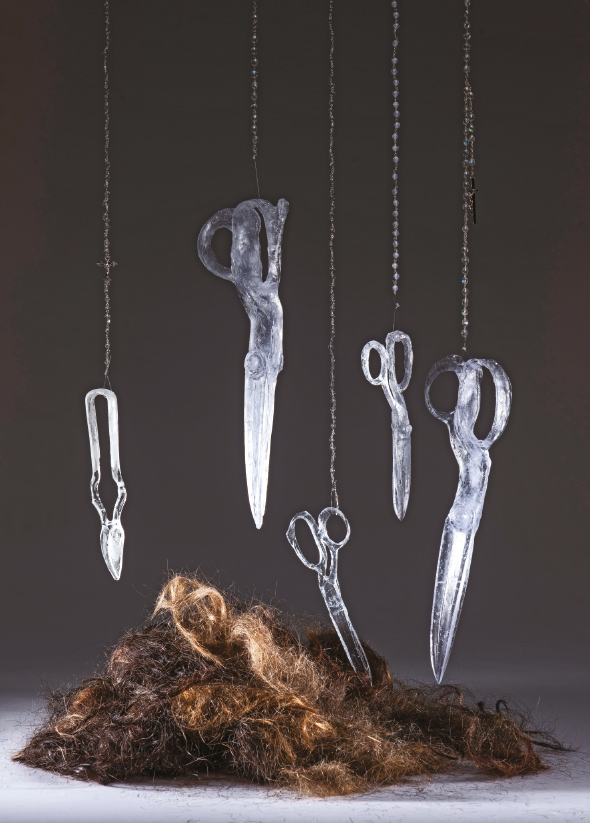
Museum of Ireland.
Eoin Meegan
Through the medium of glass and sculpture, artist Alison Lowry’s exhibition; ‘(A) Dressing Our Hidden Truths’, now running at the National Museum, shines a light on a world that has, for too long, remained locked away in the dark, hidden caverns of our past.
It is divided into four parts: commentary on the Magdalene Laundries, the Mother and Baby Homes, and a response to rape and domestic violence through the twin media of sculpture and video, the exhibition incorporates art, found objects, photographs, and oral testimonies. It is billed as an “artistic response” to the Catholic-led institutions and “the ongoing hidden truths of rape culture, consent and domestic violence.”
Entering the exhibition is like going into a forbidden cave – dark and somewhat intimidating. Immediately, you are met by images of violence and
oppression; scissors, glass, shorn locks, even something as seemingly innocuous as an apron.
Scissors made from glass suspended on rosary beads dangle precariously over a pile of human hair, symbolising an ever-present threat, as well as the loss of beauty, of innocence, and youth.
Lowry had a dressmaker make a laundry workers’ apron, then painted it with glue and sprinkled glass over it, but without putting it through a kiln (unfired). She wanted a dazzling white that was a reflection of the ethos of the time and the institution, the idea that sin needed to be ‘washed away’, that cleanliness was next to godliness. Its stiff starch whiteness evokes, in a rather bizarre way, a wedding dress. Simple, but fiercely poignant is an embroidered sheet which rests, neatly folded, on an old battered suitcase.
A collage of tiny paper dolls spilling out of church offertory bags was fashioned out of an old five pound note bearing the image of Catherine McAuley, founder of the Religious Sisters of Mercy. The note was enlarged and then cut into the miniature dolls, 10,000 in all, representing the number of women estimated to have gone through the Magdalene Laundry system since Irish Independence in 1922.
The revelations of the Tuam Mother and Baby Home, where it is believed many infants were ‘buried’ in an unused septic tank between 1925 and 1961 form an important part of this exhibition and deservedly have two whole rooms allocated to the massacre. Stepping inside we are met with the eldritch spectre of eight christening robes and a partial one, made of pate de verre (glass paste), hanging forlornly on clothes hangers. The pieces are accompanied by a recording of the 796 children’s names being read out in the background as well as displayed on a wall screen. There is a palpable sense of absence here.
Among the audio interactive pieces are commentaries of young women telling their own stories. Diane Croghan was only eight years old when she was taken by the local priest to a laundry in Wexford.
Diane escaped at the age of 13 by smuggling herself out in the back of a laundry van. She tells how the priest who took her in told her she was going to a school to be educated as a lady, and on the very first day she was put to work in the laundries.
We hear too from Connie Roberts who grew up in an industrial school along with her siblings; now a successful poet living in New York (her poem ‘My People’ is included in the exhibition), and the late Catherine Whelan.
Abandoned by her father when her mother died and he remarried, Catherine was put into the Good Shepherd Laundry at only 14. She describes how hair-cutting and other forms of discipline were frequently administered within the Laundry system as a form of punishment, as well as a way of keeping the girls and women in check.
More covert forms of violence are unmasked in a ‘New Skin’, a chilling commentary on how an extreme, violent attack such as rape can cause us to disassociate with, and even reject our own body.
In this piece, a leather figure is encapsulated in a ‘skin’ of glass, which both covers and reveals the injured body beneath. The sculpture, a response by Lowry to a survivor of sexual assault, is created in collaboration with international designer Úna Burke.
The piece seems to breathe a duality of strength and vulnerability. Psychoanalysts have claimed that self-harming or tattooing can often be the traumatised person’s way of dealing with the assault. It can also be an attempt to gain ownership of the trauma.
The theme of white is echoed in the final piece, a video performance by Jayne Cherry. Here, attired in a wedding dress and wearing glass slippers, a woman takes 35 laborious steps with the aid of two glass poles, while uttering 35 “I can’t”s. The seemingly random number is in fact drawn from the statistic that on average a woman is assaulted 35 times before reporting the abuse.
‘(A) Dressing Our Hidden Truths’ is an event of major significance, a mirror held up to a darker time in our past, while also reminding us that violence and sexual assault is something women today still have to endure. It is not nostalgic, and it is not judgmental, but it is extremely raw. It is not pleasant to experience, nor is it meant to be. Going to see it is an act of
remembrance.
Alison Lowry is an artist who works in glass and has won many awards, including being the only Irish artist to have been awarded a month-long residency (in April 2014) at the studio of the world-renowned Corning Museum of Glass, Upstate
New York.
‘(A) Dressing Our Hidden Truths’ is currently showing at the National Museum (Decorative Arts and History), Collins Barracks, Dublin.



